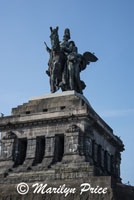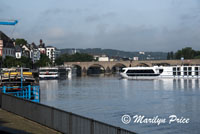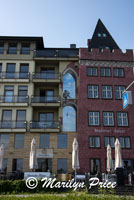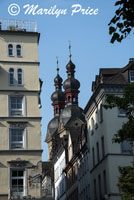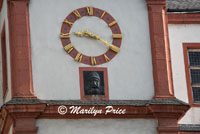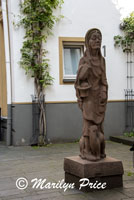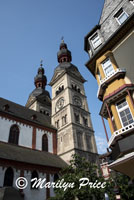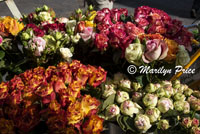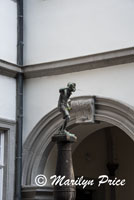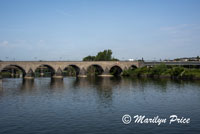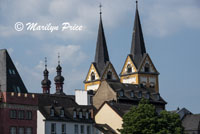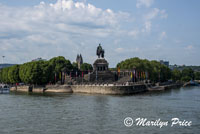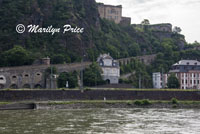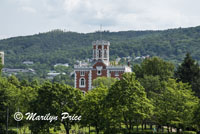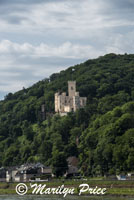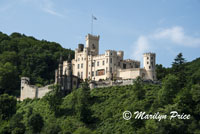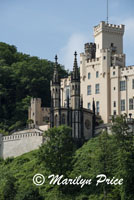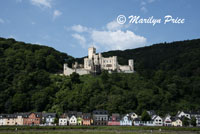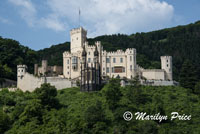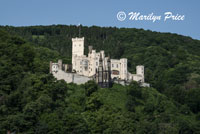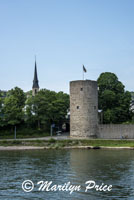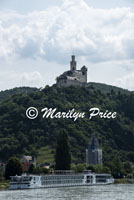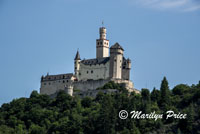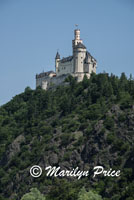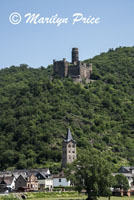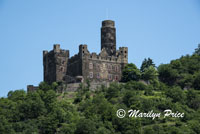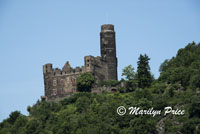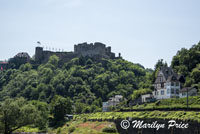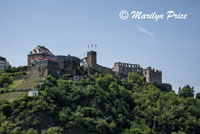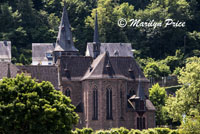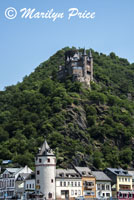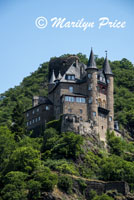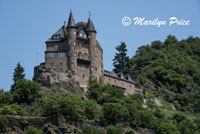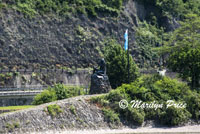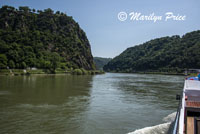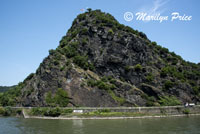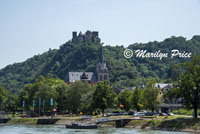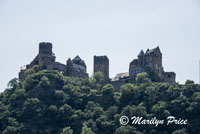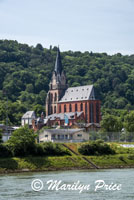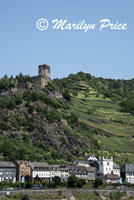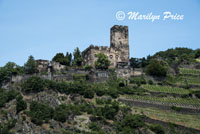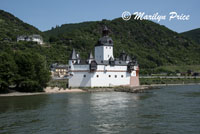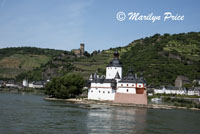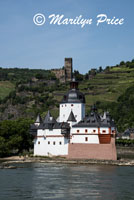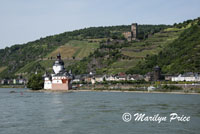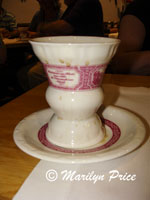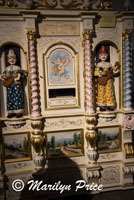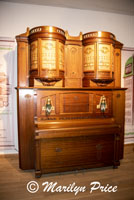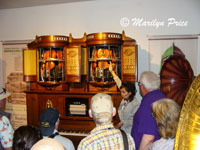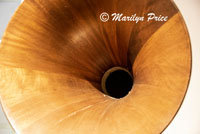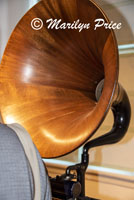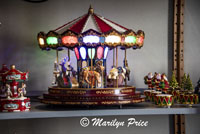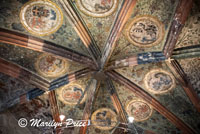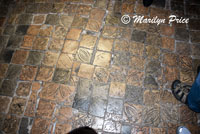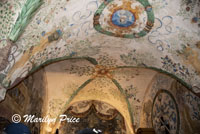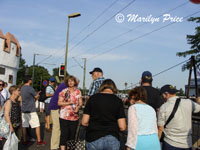May 31
June 1
June 2
June 3
June 4
June 5
June 6
June 7
June 8
June 9
June 10
June 11
June 12
Tuesday, June 4
We were underway all night, arriving in Koblenz about 8am. Koblenz is located at the confluence of the Rhine and Moselle Rivers.
We took the walking tour (after breakfast). It was another interesting walk. The walk started by walking along the riverside. Our boat was docked on the Moselle River side of town. At the confluence of the Rhine and the Moselle is a large park celebrating Germany.
The dominating fixture of this park is the large statue of Emperor Wilhelm I (photo on the left above). The center photo shows a bridge over the Moselle. The riverboat in the photo is turning around to park next to ours. Our ship is the one on the left of the river bank - you can only see the front of it. The photo on the right above shows a crooked building that our guide pointed out to us. One side of it had settled more than the other. If not for the trapezoidal piece of wall connecting it to the building on the left, the building on the right would have collapsed years ago.
These three photos show scenes around Koblenz. The photo on the left shows the towers of Liebfrauenkirche rising above some of the other buildings in the old part of town. The center photo is the clock on the town hall. Below the clock is a figure of a man. The story we were told (as I remember it) was that this was one of the town rascals (reputed to have shifty eyes) who was sentenced to death. As the sentence was about to be carried out, he stuck out his tongue at the town elders. The figure here has eyes that shift back and forth using the same mechanism that a clock's pendulum performs. Every 15 minutes, it sticks its tongue out at the people below....
The photo on the right above is a statue of the peppermint lady, another town character. The story goes that she would make peppermints and sell them to the men as they left the local taverns - to cover the smell of alcohol on their breath. She then used the money for two things - to feed stray cats (like the ones depicted at her feet) and to buy alcohol for herself. Supposedly, she once went into the local church to sit and contemplate how else to use her money and asked that question out loud, thinking herself to be alone in the church. She didn't know that the priest was a row or so behind her... He said she could donate it to the church. Well, still not seeing the priest, she told Jesus to shove it and left the church in a huff, never to return. Or so I remember the story going....
The photo on the left above is another view of the towers of Liebfrauenkirche. The center photo shows some baskets of roses that were being put out for sale. The photo on the right shows a statue of another Koblenz legend - a spitting boy. It refers to the young boys that were born during a 20 year period when Koblenz was part of France. Some of these children roamed the streets, reviled by the citizens. So they would occasionally spit on them as a jest. This statue also spits at irregular intervals, splattering the unsuspecting. If you look closely at the larger version of this, you can see the stream of water...
We left Koblenz a little after 10 and headed back up the Moselle and onto the Rhine.
The photo on the left above shows the bridge over the Moselle as we pulled away from the shore. The center photo shows two sets of church towers rising above the old town. Florinskirche is the closer one, Liebfrauenkirche is the farther set. The photo on the right shows Deutsches Eck, the German heritage park at the confluence of the Rhine and Moselle Rivers with its large statue to Wilhelm I.
The photo on the left shows some of the fortifications along the road leading to Ehrenbreitstein Castle, a hilltop fortress that looms over Koblenz.
The photo on the right is an interesting looking building that we passed after we left Koblenz. I never did find out what it was...
There are a lot of castles along the way today. Lunch was carefully planned for a longer stretch between castles...
These three photos (and the next three) show Stolzenfels Castle, one of the prettiest castles we would see this afternoon. The view changed as we progressed up the river. Stolzenfels Castle is an example of 10th century Rhine Romanticism. It was a summer residence for King Friedrich Wilhelm IV of Prussia. Like Neuschwanstein Castle in Bavaria, it is characterized by a lot of small decorative towers and other extravagent ornamental elements.
This stretch of the Rhine may have a lot of castles, but it also had several small towns. The photo on the left shows some former fortifications for one of the small towns we passed. I don't know which town it was.
.
.
.
.
These three photos show views of Marksburg Castle. The photo on the left shows a riverboat docked below the castle. Marksburg Castle is one of the few along this river to never have been destroyed and retains much of its original 14th century condition, including a high keep, mighty defensive walls and bastions, a knight's hall, chapel, and armory.
These three photos show the next castle up the river - Maus Castle. This is one of a pair of castles that "watch" each other across the Rhine. The other is called Katz Castle (further down this page). Our riverboat handout says they watch each other like a cat and mouse.....
Continuing up river, we came to Rheinfels Castle (the photo on the left and center above). It was once the largest fortress on the Rhine. The photo on the right shows a nice church in the town below Rheinfels.
These three photos show views of Katz Castle. The photo on the left also shows the town of St. Goarshausen, nestled in the shadow of Katz.
We were soon approaching Lorelei Rock, which marks the narrowest point in the Rhine Gorge. The current runs swiftly around this feature. Up until the 19th century, the rock cliffs and swift undercurrent required use of special pilots to navigate. This section has now been smoothed out, but it's still a treacherous passage and ships tend to go through the area in single file.
There were many legends explaining the area. In 1822, Heinrich Heine gave the legend its final form - that a beautiful young maiden would sit on the rock below this cliff, combing her long hair and singing, luring mariners onto the rocks.
The photo to the left above shows the statue of the Lorelei, mounted on the rocks below the summit. The center photo shows the chasm as we approached from downriver. The Lorelei Rock is the tall prominence on the left. The photo on the right shows the view looking back at the Lorelei Rock after passing through the narrowest point (370 feet across).
Continuing upriver, our next castle is Schonburg Castle and its small town of Obervesel. This castle has some very well preserved Medieval walls and defenses. The photo to the left above shows this castle and town. The center photo shows a closer view of Schonburg Castle. The photo to the right shows one of the churches in Obervesel.
The photo on the left above shows Gutenfels Castle and the town of Kaub. The center photo is another view of Gutenfels Castle. The photo on the right is Pfalzgrafenstein Castle, an island fortress on the edge of Kaub. There weren't many notes about these two castles, other than the fact that a photo of the two together is a classic photo op of the Rhine. The three photos below show these two castles together.
We finally left the upper deck about 3, even though we would continue to pass more castles. I think we saw the cream of the crop.
I returned to our room to download and label images. We just barely made it to the daily briefing at 4 pm.
The ship docked in Rudesheim a little later than captain planned. We were soon loaded onto the tourist “train” to the upper city for special “kaffee”. I passed as it had coffee, milk, and chocolate. Carl said it was okay, but nothing to write home about. It was served in a special cup (photo on the left) with three cubes of sugar, local brandy – which is then set on fire to caramelize it, then strong coffee, milk, and shaved chocolate.
Then we walked up the hill to the Siegfried's Mechanical Instrument Cabinet – an exhibit of mechanical music boxes and such. Some were really fantastic. That part was really worth while, unlike the kaffee shop.
These three photos are from the mechanical instrument museum. The photo on the left shows an instrument similar ot a player piano that was used with carousels. It was really loud when the docent turned it on!!! The other two photos show views of a player piano that incorporated violins as well as the piano strings. The center photo shows it closed. The photo on the right shows it open in operation. Very different!
The photo on the left and the center photo show two views of the wooden bell of an Edison gramaphone. The photo on the right shows one of the more elaborate music boxes they had in the gift shop. I didn't even WANT to check the pricetag....
This museum was in a very old building, dating from the 1600s. The photos to the left and right above show part of the preserved ceiling in one room. The center photo shows the well worn tiles that make up the floor to the same room.
Then Carl and I visited a Christmas oriented shop (I didn't buy anything).
Then we headed downhill, back towards the river and the ship. As we neared the river, we had to cross the train tracks. The recommended crossing wasn't working correctly - a train had passed by, but the gates didn't reopen. The lights continued their warning, and it was impossible to cross! So, we walked a little farther down the path to an underpass that passed under the tracks before leading directly to the ship. So much for the cruise director's instructions... The photo on the left shows a group of fellow passengers waiting for the gate to open.
We got to the ship as they were starting to serve dinner, so we dropped the camera and other stuff in our room and headed straight to the dining room. I would have liked to have taken a shower, but.... Carl's main dish tonight was tortellini. Mine was trout.
We bypassed the evening's entertainment to head to bed. Tomorrow will start soon enough.
Before dropping into bed, we sorted out some stuff to send to the laundry. They'll pick it up in the morning.

